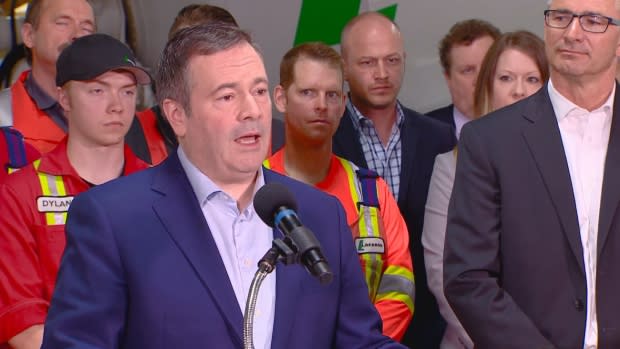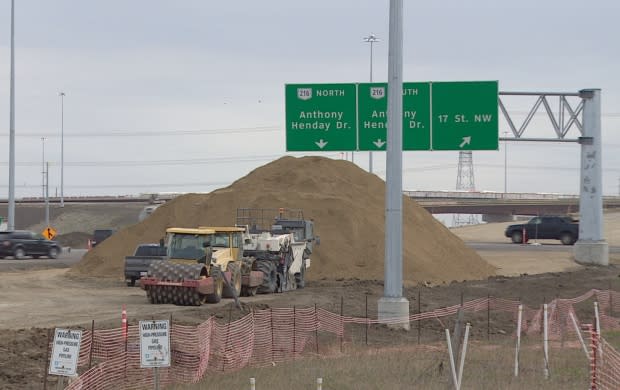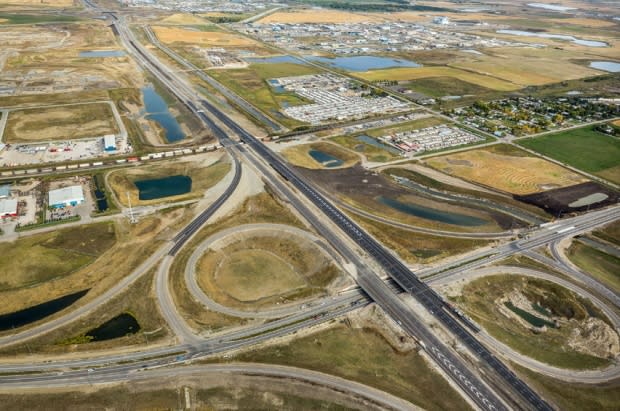The good, the bad and the money: What more P3s could mean for Alberta
Public-private partnerships are about to make a comeback in Alberta.
Premier Jason Kenney told reporters May 13 public-private partnerships are the future for infrastructure projects.
"We think in the long run, the way we can get more job-creating infrastructure to make Alberta's economy more efficient is through more public-private partnerships," Kenney said.
"We're going to be very aggressive about pursuing P3s to bring private sector capital into helping to build public infrastructure. That's one way we think we can get more bang for the taxpayer's buck."
Commonly known as P3s, the model often sees the private sector take on the majority share of financing and construction.
There are often penalties built into the contract that the private sector is forced to pay if, for example, there are delays.
'Balancing act'
Alberta is no stranger to P3 infrastructure projects.
For some previous provincial governments, the P3 model has been a way to invest in infrastructure projects while putting most of the risk into the private sector's lap.
The coupling of private and public sectors can be a great thing for any province, some experts say.
The design of many P3 contracts does put a fair amount of responsibility of public infrastructure into the hands of the private sector, said Teresa Kramarz, associate professor at the Munk School of Global Affairs and Public Policy at the University of Toronto and co-director of Environmental Governance Lab.
"Whenever you contract out, there's a certain degree of slack that the contractor has, interpretation that they have, in order to carry out the contract. You're giving them a certain amount of slack in order to do their job the best they can," said Kramarz.
P3s can be the right approach to a project but they are "a balancing act," she says.
The government balances its needs through control over the private sector, while still giving enough "slack" to the private sector so they can use their skill set to get the job done, she added.

But sometimes, that balance can falter.
"That contracted company is also there to yes, use their expertise. Yes, get more business so to do a good job but also to generate profit.
"So if it comes to a point in which it's generating loss, they might cut corners. They might do it in a way that pays attention to their bottom line but doesn't pay attention to a broader public concern."
There are other known risks when dealing with the private sector through the P3 model.
In Ontario, a report released by the auditor general in 2014, found that 74 P3 projects in that province cost taxpayers $8 billion more than expected over nine years.
One of the reasons? Private companies pay much more for financing than governments do, the audit found.
Infrastructure Ontario at the time told CBC the $8-billion hole was worth it, since it ensures those projects are built on time and on budget, and saved the province from $18.6 billion in potential cost overruns.
Timothy Murphy is a lawyer with McMillan LLP, who has been involved with nearly 100 P3s projects across the country through the private sector.
At end of day, the decision needs to fit the needs of the people - Teresa Kramarz
He says that it's critical for governments to have the expertise when deciding if a project should go the P3 route.
"You only use [P3s] when it's the right answer. If it's not, from an efficiency and effectiveness point of view, you don't use it," Murphy said.
Kramarz agrees.
"At the end of day, the decision needs to fit the needs of the people," she said.
Alberta supporter of P3s historically
Several major infrastructure projects in Alberta have been done through a P3 model, including the construction of portions of Edmonton and Calgary's ring roads.
Schools and wastewater treatment plants across the province have also been built under the public-private partnership formula.
"Alberta has historically been supporters of public-private partnerships," said Mark Romoff, president of Canadian Council for Public-Private Partnerships, which advocates for innovative P3 projects.
"That did change under premier Notley."
Evaluating a P3 project
For governments that invest in the P3 model, a project's success is often evaluated by finishing on time and within budget, Romoff said.
"Those tend to be the sort of measures that international governments look at because citizens want stuff built faster, better and cheaper. It's just the nature of it," he added.
By those standards alone, many projects in Alberta have done well, according to government figures.
Provincial statistics provided to CBC show 40 schools and Kananskis's water and wastewater treatment plant built using the P3 model were all completed on time and on budget.
Experts say those are tangible wins for taxpayers.
"When it is the right project and structured in the right way, we have found that public-private partnerships in Canada have really been very effective both in terms of bringing projects in on time and on budget. But more importantly, with significant economic impact," Romoff said.
But not every project in the province has met those standards of success.
The southeast portion of the Calgary ring road was delayed and the contractor was penalized, according to a provincial government spokesperson.

The first portion of the Valley Line LRT, which is still under construction through a P3 model, has been delayed by an unspecified amount of time.
School builds also under the P3 model have presented some school boards in the province with issues.
Edmonton Public Schools Board chair Michelle Draper said Tuesday there have been some post-construction woes.
"We have P3 schools. There's been some challenges and we're working to address those. Different models look different ways, so I'm keen to meet with the premier, the minister of education and minister of infrastructure and look at what we can do to address the infrastructure and space crunch needs of Edmonton Public [schools]," Draper said.
In 2007, Alberta announced 18 new schools would be built as public-private partnerships.

But three years later, the province's auditor general, Merwan Saher, said the government's claim that $118 million would be saved under the partnerships versus traditional builds, was overstated by about $20 million.
Romoff says the P3 model doesn't fit every project, which is why it's important the public sector properly identifies projects that will work.
"What you want are really well-formed partnerships between government and the private sector and a commitment to getting things built and maintained over their lifecycle in a way that works for you and me. Because in the end, it's us, the taxpayers, that really are focused on this."
Former P3 projects in Alberta
Here are some examples of previous P3 projects in Alberta.
Southeast section of Stoney Trail ring road
One of three sections of Calgary's ring road using the P3 model, the southeast section was completed in late November 2013, 52 days past its deadline. The consortium building the 25-kilometre stretch of road was fined a total of $3.64 million for the delay.
On time? No
On budget? Yes
Calgary Composting Facility
It's the largest facility of its kind in Canada and processes upwards of 145,500 metric tons of food and yard waste, as well as biosolids, from across the city and turns it into soil. The facility is owned by the city, but operated by AIM Environmental.
On time? Yes
On budget? Yes

Southeast section of Anthony Henday Drive
The government at the time credited the on-time and under budget success of this project to the P3 model. This was Alberta's first highway project built in partnership with a private company.
On time? Yes
On budget? Yes
Evan-Thomas Water and Wastewater Treatment Facility (Kananaskis)
Serving a small population and popular recreational area, this $59.6-million water treatment plant in a natural setting faced stiff regulatory conditions. It required Epcor to design, build and then operate the facility for 10 years.
On time? No
On budget? Yes
Northeast section of Anthony Henday Drive
The 27-kilometre, $1.81-billion northeast portion of the Anthony Henday Drive completed Edmonton's ring road when it opened to the public in 2016.
On time? Yes
On budget? Yes

